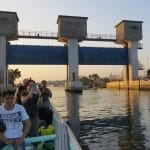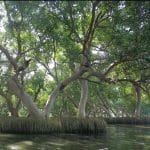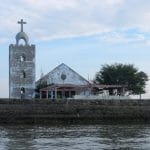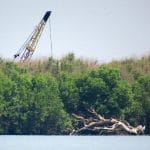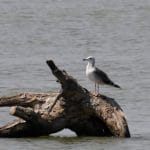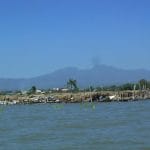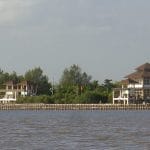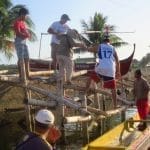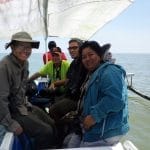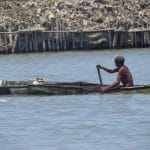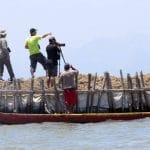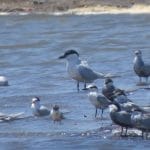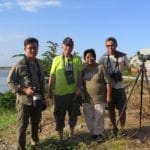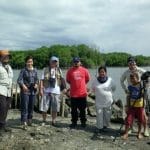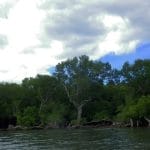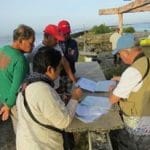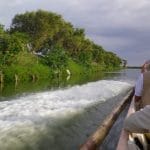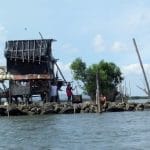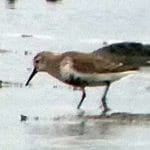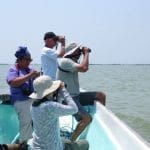The Manila Bay Experience
By: Cristina R. Cinco
Let the quest for the water birds begin! Manila Bay covers more than 1,900 square kilometres and has a coastline of 190 kilometers spanning the provinces of Cavite and Metro Manila in the east, Bulacan and Pampanga in the north and Bataan in the west/northwest. The varied habitats like mangrove forests, sandy beaches and mudflats make ideal locations to find shorebirds. The survey serves as an extension of the Asian Waterfowl Census as WBCP’s resident ornithologist and Associated Expert of Wetlands International, Arne Jensen organized a series of explorations of Manila Bay searching for migratory water birds, locating possible new bird watching and conservation sites along its coasts and river tributaries. Here I am sharing my experiences during the series of Manila Bay surveys.
NAVOTAS TO PAMPANGA RIVER
The first expedition was in April 02, 2016. The team was composed Arne Jensen, Christian Perez, Ivan Sarenas, Maia Tanedo, Jasmin Meren and myself. Armed with our binoculars, spotting scopes and cameras we were off to an adventure, open to all possibilities, unaware of what situations to expect or migratory species that we may encounter. Our quest of Manila Bay began at the northern most point of Metro Manila at Navotas reaching to the mouth of the Pampanga River which is the border between Pampanga and Bulacan.
First stop was at the white Chapel in Baluarte, Obando, Bulacan. Arne recalled that the first club trip to Baluarte was done in 2004. The ruins of the white chapel amidst the remnants of former fishponds during the early morning was a sight to behold. But the ruins also meant that nothing is permanent when water claims its place. Nature’s wrath like storm surges can destroy even concrete structures built along the shore.
While travelling close to the shoreline of Manila Bay , we observed thousand of Whiskered Terns together with several uncommon waterbird species like the Chinese Egret and several Black-tailed Godwits. By noontime we decided to take a break at Masukol fish port in Paombong, Bulacan. The only means of access to this part of Bulacan is by boat. Curious stares met us from the local people as we ate our packed lunches al fresco.
By mid afternoon, we reached our final destination at the mouth of the Pampanga River. Dredging activities were being done in the Macabebe side of Pampanga River. Being a warm Sunday afternoon, people were picnicking and swimming in the bay to cool off from the summer heat. This part of Manila Bay seemed like a secret and convenient beach for the locals to enjoy a summer holiday.
Before heading back to Navotas , Arne, Christian, Ivan and Jasmin took the paddle boat further into the Pampanga River. There were close to a thousand Black-headed gulls, a lone Caspian Tern and the surprise bird for this trip- a provisional id of a large gull, an immature Lesser Black-backed gull, a country record yet to be validated by the experts.
After the excitement from the Lesser Black-backed Gull, it was time to head back to Navotas. We were travelling at full speed , going against the wind and racing the waters trying to avoid a brewing thunderstorm. We reached Navotas close to sunset, soaking wet from the splashing waves in what Jasmin called “mini tsunamis”, with several sardines and other fishes jumping into the boat. Yes , we lost the race against time, getting caught in a thunderstorm while navigating through the Malabon Navotas River. Despite basking under the blazing sun and being rained out at the day’s end, we all agreed that this was an unforgettable and unique birdwatching experience! The expedition honed further our id skills on waders while adding some lifers to our bird list. But best of all our team was one of the first to have the privilege of viewing the scenic spots that very people know of in north Manila Bay.

MANILA BAY BATAAN FROM BALANGA TO ORANI
On April 09,2016, another survey was done from the Bataan side of Manila Bay. Taking part of the group that Arne organized together with Mads Bajarias and James Biron. From Brgy. Tortugas in Balanga we cruised along coastal towns of Bataan including the river tributaries of Samal. I almost did not make it to the boat ride. It was a difficult descent getting to the boat from the makeshift bamboo wharf in Tortugas that three men had to assist on getting me on board!
The search for migrating waterbirds along the coast of Bataan was almost futile. Our survey was hampered by the enormous fishponds and fish cages that it was almost impossible to come closer to the shoreline. The distance from the water made it difficult to find the waders. Our motorized boat even ran over several net enclosures along the bay. Lower counts of the terns, plovers and other shorebirds were noted, assuming that they were already on their way back to their home grounds in Northern Asia.
Towards the early afternoon, shifting winds and rising tides prompted us to cut short our boat trip. Rather than returning back to Balanga by boat and getting wet again from the splashing waves, Arne opted to disembark at the Orani fish market. We continued to look for waders along the coastal highway between Orani and Balanga, scanning the rivers and fishponds making brief stops in the towns of Abucay and Samal. Just before sunset, the survey for the 2016 Spring Migration of shorebirds came to an end at Puerto Rivas in Balanga City. Arne as one of the bird club’s founding member, reminisced how Puerto Rivas was just a newly discovered birding site more than 10 years. What began as the first out of town trip for the bird club has now evolved into one of the most favoured birdwatching sites in the country. Puerto Rivas is now in the birdwatching map, influencing Balanga City’s environmental policies.
VENTURING INTO THE RIVERS OF BULACAN FROM MANILA BAY
Almost a year after the trip along coastal Bataan, bird surveys were organized in January and February of 2017. The team was led by Arne with Maia Tanedo, Mark Jason Villa and myself. We explored the river systems in Bulacan connected to Manila Bay, using satellite based maps to plot out geographic locations with the identification and listing of migratory birds found along the way. A first in Philippine birdwatching history, a drone was launched to record aerial views of large congregations of waterbirds in mangrove forests, fish ponds,sandy beaches and mudflats.
The survey team navigated in and out of Manila Bay into the rivers and streams of Taliptip, Dapdap,Bugwan, Tawiran and Pamarawan in Bulacan.
High numbers of Whiskered Terns, Black-headed Gulls and even several Caspian Terns were observed. Hundreds of Kentish and Pacific Golden Plovers were noted. Globally threatened and Near Threatened species like the Chinese Egret. The Eurasian and Far Eastern Curlews were also present. We even saw eight Ospreys lording it over a fishpond along the Bamban River. The surprise bird of the Bulacan river survey was the Dunlin. Mark Villa spotted the Dunlin in the salt pans of Pamarawan. This bird was last sighted in the 1970’s from the province of Cagayan in the north.
Doing the traverse of Manila Bay takes a lot of organization, patience and stamina. Early morning meet ups, coordinating transportation arrangements from boat rentals to land transfers, safely packing optical equipment in dry bags, to making provisions for sufficient food and drinks to last a whole day are all part of the preparations . A learning experience in real time, Manila Bay became one big classroom acquiring further knowledge in identifying waterbirds, map reading , locating satellite plotted coordinates and data gathering on its various habitats found along the coasts and river banks. A physically challenging outdoor activity boarding boats, climbing fishpond dikes, treading upon the mud, chasing low tides and being under the sun from dawn to dusk.
Manila Bay is a lifeline for the people that live within its bounds. From the sardines that is caught in its waters, to the biodiversity it supports , to the river systems serving as waterways to transport people to various destinations. An important wintering habitat for migratory birds along the East Asian Australasian Flyway for which the Northern Manila Bay hosts up to 19 waterbird populations in numbers of international importance, for example, up to 20% of the flyway population of Great Egrets. In terms of total waterbird numbers, there is no other place in the Philippines that host to so many waterbirds as Manila Bay. Indeed a rare privilege to participate in the Manila Bay expeditions, coming full circle – evolving from being a mere birdwatching enthusiast to citizen scientist to simply a nature lover who appreciates the waters that bounds Metro Manila for its scenic views and the various life forms that this bay supports.

